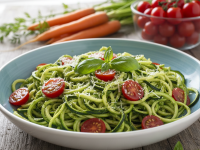Hey there, fellow food lovers! Ever found yourself in the kitchen, happily prepping a batch of fresh tomatoes for a sauce or salad, only to toss those fragrant stems straight into the compost or, gasp, the trash? I used to do it all the time. It felt like a necessary evil, a byproduct of deliciousness. But what if I told you those humble, discarded tomato stems are actually culinary gold, packed with a secret weapon of flavor just waiting to be unleashed?
That’s right! I’m talking about Tomato Stem Broth – a revelation that completely transformed my approach to kitchen waste and flavor building. If you’re anything like me, always looking for ways to maximize ingredients, reduce waste, and add a layer of depth to your cooking that makes people say, “What’s in this?!”, then you are in for a treat. This isn’t just a recipe; it’s a philosophy. It’s about turning something overlooked into a cornerstone of savory goodness. Let’s dive into how I discovered this amazing trick and how you can make your own liquid magic.
Why Tomato Stems? Unlocking Hidden Umami and Green Freshness
My journey to tomato stem broth began, as many good kitchen experiments do, with a little bit of curiosity and a lot of tomatoes. I was making a huge batch of passata one summer, and the pile of discarded stems seemed criminal. They smelled so intensely green, so… tomato-y. It struck me: if the fruit holds so much flavor, surely the plant’s backbone does too?
And boy, was I right! Tomato stems, particularly the fresher ones, are brimming with compounds that contribute a unique, verdant aroma and an incredible depth of umami. This isn’t the same flavor you get from the fruit; it’s earthier, greener, almost herbaceous, and incredibly savory. When simmered gently, they release these complex notes, creating a broth that’s vibrant, subtly sweet, and wonderfully aromatic. It’s like bottling the very essence of a suy tomato garden.
I remember the first time I made it. The aroma filling my kitchen was intoxicating. It wasn’t just a regular vegetable broth smell; it was distinct, brighter, and undeniably “tomato” without being overtly acidic like a tomato puree. It added a layer of freshness to my cooking that I simply couldn’t achieve with store-bought broths or even my regular homemade vegetable stock. It’s truly a zero-waste win, transforming what would otherwise be discarded into a powerful flavor enhancer.
Gathering Your Green Gold: What You’ll Need
The beauty of this broth is its simplicity and reliance on things you might already have or would otherwise throw away. Think of it as a culinary treasure hunt in your own kitchen! Here’s what I typically gather:
- Tomato Stems: This is the star of the show, obviously! I collect them from various cooking projects – salads, sauces, sandwiches. Keep them clean and store them in a freezer bag until you have a good amount. I usually aim for about 2-3 cups, loosely packed, for a decent batch of broth. Make sure they are just the stems, with no actual tomato fruit attached, as that can make the broth too acidic.
- Aromatics (My Usual Suspects for Flavor):
- Onion Scraps: Ends, peels, any bits you’d usually toss.
- Carrot Peels & Ends: Adds a touch of sweetness.
- Celery Ends & Leaves: For classic savory notes.
- Garlic Peels & Ends: A hint of pungency.
- Mushroom Stems (Optional but Recommended): If you have them, they boost the umami beautifully.
- Herbs & Spices:
- Bay Leaf: 1-2, for a classic, savory base.
- Black Peppercorns: About 1 teaspoon, whole.
- Parsley Stems (Optional): If you’ve got them from other cooking, they add freshness.
- Thyme Sprigs (Optional): A few sprigs for an earthy undertone.
- Liquid:
- Water: About 8-10 cups, depending on how concentrated you want your broth.
- A Splash of Apple Cider Vinegar (Optional): About 1 tablespoon. This helps extract more flavor from the vegetables, especially the stems, without making the broth taste like vinegar. It’s a little trick I picked up over time!
- Equipment:
- Large stockpot or Dutch oven
- Fine-mesh sieve or colander lined with cheesecloth
- Storage containers (jars, freezer-safe bags, or ice cube trays)
One pro tip I’ve learned: start a “broth bag” in your freezer. Every time you chop vegetables, toss the clean scraps (onion skins, carrot ends, celery leaves, garlic peels, and, of course, tomato stems!) into this bag. When it’s full, you’re ready to make broth. It’s an incredibly satisfying feeling to turn potential waste into something so delicious.
My Journey to Broth Nirvana: The Step-by-Step Recipe
Okay, enough talk! Let’s get cooking. This is a wonderfully forgiving recipe, so don’t stress too much about exact measurements. It’s more about the process and the intent.
Step 1: Prep Your “Waste” (It’s Not Waste Anymore!)
First things first, make sure all your collected tomato stems and other vegetable scraps are clean. Give them a good rinse under cold water. If you’ve frozen them, no need to thaw – just add them straight to the pot.
Step 2: A Little Sauté (Optional, But I Swear By It)
While you can just dump everything in, I find that a quick sauté of the aromatics first adds a layer of depth. Heat a tablespoon of olive oil in your large stockpot over medium heat. Add your onion scraps, carrot peels, and celery ends. Sauté for about 5-7 minutes, stirring occasionally, until they start to soften and become fragrant. This caramelization adds a lovely sweetness and complexity to the finished broth. You don’t need to brown them heavily, just soften them up a bit.
Step 3: Build the Broth Base
Now, add your cleaned tomato stems, garlic peels, mushroom stems (if using), bay leaves, peppercorns, and any other herb stems you’re using to the pot. Give it all a good stir. Pour in your water, ensuring all the solids are submerged. If you’re using the apple cider vinegar, add that now too. Bring the mixture to a gentle boil, then immediately reduce the heat to a low simmer.
Step 4: The Gentle Simmer
This is where the magic happens. Cover the pot, leaving a small crack for steam to escape, and let it simmer for at least 1 hour, or up to 2 hours. I’ve found that 1.5 hours is my sweet spot. A longer simmer will extract more flavor, but be careful not to overdo it, especially with the tomato stems, as prolonged simmering can sometimes introduce a slightly bitter note. Keep it at a very gentle simmer – you should see just a few small bubbles breaking the surface, not a rolling boil.
During this time, your kitchen will start smelling absolutely divine. It’s one of my favorite smells – fresh, earthy, and deeply comforting.
Step 5: Strain Your Liquid Gold
Once your broth has simmered, turn off the heat and let it cool slightly in the pot for about 10-15 minutes. Then, carefully strain the broth through a fine-mesh sieve (or a colander lined with cheesecloth for extra clarity) into a large bowl or another clean pot. Press down on the solids with the back of a spoon to extract every last drop of flavorful liquid. Discard the spent solids (they’ve given all they have!).
Step 6: Cool and Store
Allow the strained broth to cool completely before storing. This is important for food safety. Once cool, transfer the broth to airtight containers. I like to use glass jars or freezer-safe bags. It will keep in the refrigerator for up to 5 days, or you can freeze it for up to 3-4 months. I often freeze it in 1-cup portions or even in ice cube trays for smaller amounts – perfect for deglazing a pan or adding a flavor boost to a sauce!
Beyond the Broth Bowl: How I Use My Tomato Stem Elixir
Having a stash of this tomato stem broth in my freezer is like having a secret weapon in my culinary arsenal. It’s so versatile! Here are some of my favorite ways to use it:
- Soups and Stews: This is its obvious home. It forms an incredible base for any vegetable soup, lentil soup, minestrone, or even a light chickeoodle soup. Its unique flavor really shines through and makes the whole dish taste more vibrant and complex. I’ve had guests ask for my “secret ingredient” in my simple tomato basil soup, and it’s often this broth!
- Cooking Grains: Instead of plain water, use tomato stem broth to cook rice, quinoa, couscous, or farro. It infuses the grains with an amazing savory depth that elevates even a simple side dish.
- Sauces and Gravies: It’s fantastic for deglazing a pan after searing vegetables or meat, capturing all those delicious browned bits. It also makes a superb base for pasta sauces, especially if you want to enhance the tomato flavor without adding more actual tomatoes.
- Braises: Use it as part of the liquid for slow-cooked dishes. It adds a subtle background note that complements meats and vegetables beautifully.
- Poaching Liquid: For a light and flavorful way to cook chicken breasts or fish fillets, simmer them gently in this broth. The delicate flavors infuse into the protein.
- A Simple Sipping Broth: On a cold day or when I just need a comforting, savory pick-me-up, I’ll warm a mug of this broth, maybe with a pinch of salt and pepper, and sip it. It’s incredibly soothing and satisfying.
Tips & Tricks from My Kitchen to Yours
- Experiment with “Waste”: Don’t limit yourself to just tomato stems and the basics. Try adding corn cobs (after you’ve eaten the corn!), clean potato peels, or even dried mushroom scraps for even more umami.
- Don’t Over-Simmer: As I mentioned, too long a simmer (especially at a vigorous boil) can sometimes extract bitterness from certain vegetables, including tomato stems. Keep it low and slow.
- Taste and Adjust: Always taste your broth before storing. If it feels a little flat, a pinch of salt can really make the flavors pop. Sometimes a tiny squeeze of lemon juice or a dash of nutritional yeast can also enhance the umami.
- Cleanliness is Key: Ensure all your scraps are clean and free of dirt or mold. This goes without saying for any food preparation!
Embracing this tomato stem broth recipe has not only made my cooking more flavorful but has also made me a more mindful and sustainable cook. It’s a wonderful feeling to know that you’re getting every last drop of goodness out of your ingredients, turning potential waste into a culinary masterpiece. So, next time you’re prepping tomatoes, resist the urge to discard those stems. Collect them, make this broth, and prepare to elevate your everyday cooking to something truly special. Happy simmering!




